1998 TOYOTA SUPRA stop start
[x] Cancel search: stop startPage 13 of 191
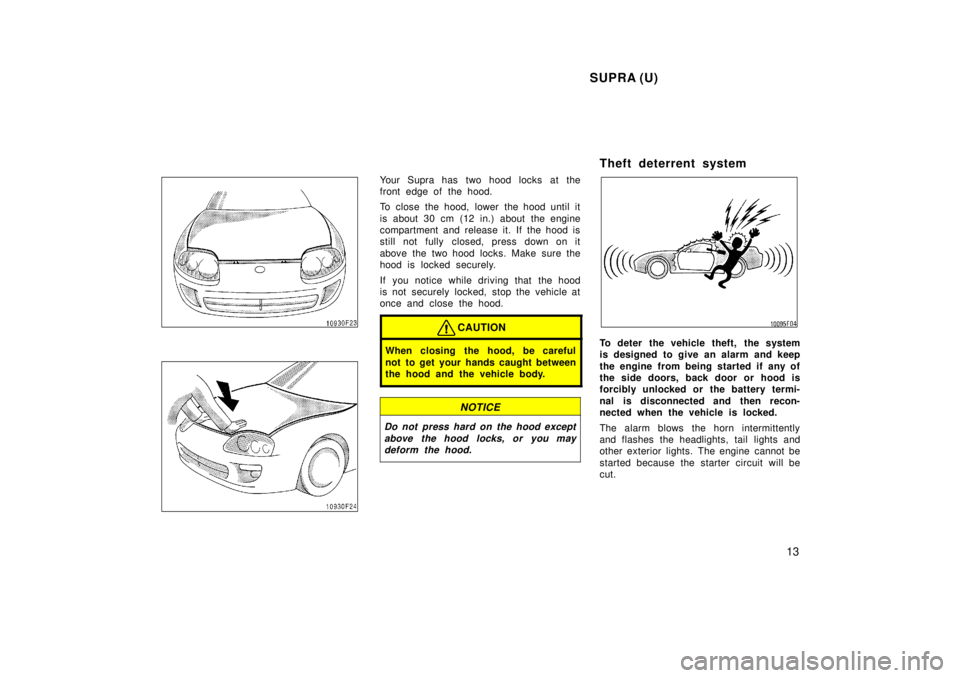
SUPRA (U)13
Your Supra has two hood locks at the
front edge of the hood.
To close the hood, lower the hood until it
is about 30 cm (12 in.) about the engine
compartment and release it. If the hood is
still not fully closed, press down on it
above the two hood locks. Make sure the
hood is locked securely.
If you notice while driving that the hood
is not securely locked, stop the vehicle at
once and close the hood.
CAUTION
When closing the hood, be careful
not to get your hands caught between
the hood and the vehicle body.
NOTICE
Do not press hard on the hood except
above the hood locks, or you maydeform the hood.
Theft deterrent system
To deter the vehicle theft, the system
is designed to give an alarm and keep
the engine from being started if any of
the side doors, back door or hood is
forcibly unlocked or the battery termi-
nal is disconnected and then recon-
nected when the vehicle is locked.
The alarm blows the horn intermittently
and flashes the headlights, tail lights and
other exterior lights. The engine cannot be
started because the starter circuit will be
cut.
Page 14 of 191

SUPRA (U)
14
SETTING THE SYSTEM 1. Turn the ignition key to the ºLOCKº position and remove it.
2. Have all passengers get out of the vehicle.
3. Close and lock all the side doors, back door and hood.
The indicator light will come on when all
the side doors, back door and hood are
closed and locked.
As the side doors are locked, the system
will give you a preparation time of 30
seconds before the setting, during which
the side doors, back door and hood may
be opened to prepare for the setting. Be careful not to use the key when open-
ing any side door. This will cancel the
system.
4. After making sure the indicator light starts flashing, you may leave the ve-
hicle.
The system will automatically be set after
the preparation time passes. The indicator
light will flash to show the system is set.
If any of the side doors, back door or
hood is open at that time, the setting is
interrupted until it is closed and locked.
Never leave anyone in the vehicle when
you set the system, because unlocking
from the inside will activate the system.
WHEN THE SYSTEM IS SET
Activating the system
The system will give the alarm and cut
the starter circuit under the following
conditions: � If any of the side doors, back door or
hood is unlocked without using the key
� If the battery terminal is disconnected
and then reconnected
After one minute, the alarm will automati-
cally stop with the starter circuit cut kept on. Reactivating the alarm
Once set, the system automatically resets
the alarm each time all the side doors,
back door and hood are closed after the
alarm stops.
The alarm will be activated again under
the following conditions:
� If any of the side doors, back door or
hood is opened
� If the battery terminal is disconnected
and then reconnected
Stopping the alarm
Turn the ignition key from the ºLOCKº to
ºACCº position. The alarm will be stopped
with the starter circuit cut kept on. Stop-
ping the alarm in this manner will keep
the alarm from being reactivated when any
of the side doors, back door or hood is opened.
Interrupting the setting
With the system set, the back door can
be opened by using the key without set-
ting off the system. While the back door
is open, the setting is interrupted and the
side doors and hood may be opened in
addition. However, when the battery termi-
nal is disconnected and then reconnected,
the system is activated.
Page 63 of 191
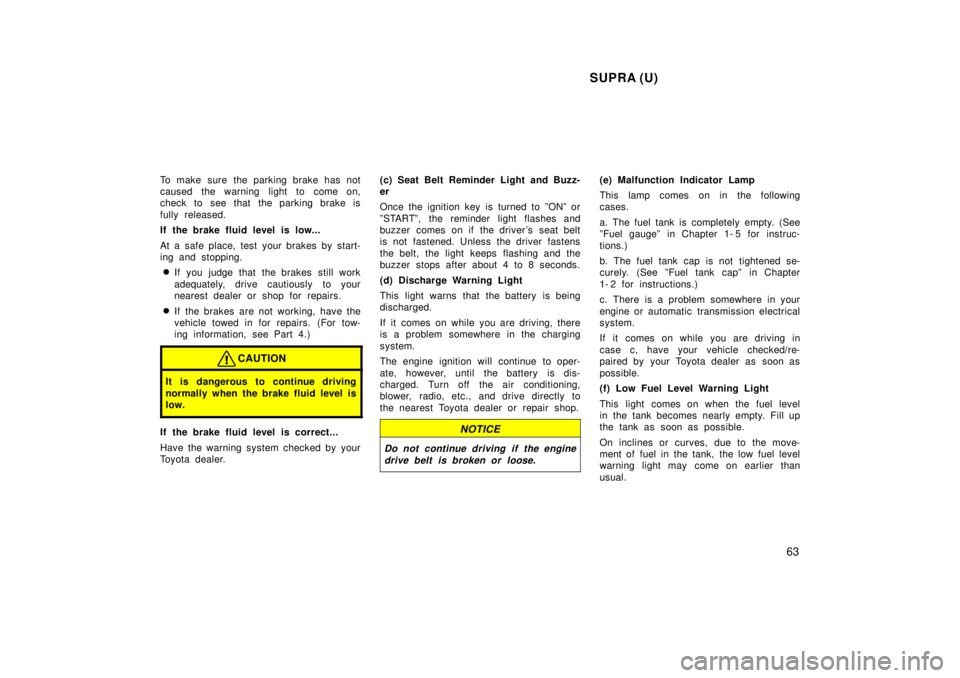
SUPRA (U)63
To make sure the parking brake has not
caused the warning light to come on,
check to see that the parking brake is
fully released.
If the brake fluid level is low...
At a safe place, test your brakes by start-
ing and stopping.
� If you judge that the brakes still work
adequately, drive cautiously to your
nearest dealer or shop for repairs.
� If the brakes are not working, have the
vehicle towed in for repairs. (For tow-
ing information, see Part 4.)
CAUTION
It is dangerous to continue driving
normally when the brake fluid level is
low.
If the brake fluid level is correct...
Have the warning system checked by your
Toyota dealer. (c) Seat Belt Reminder Light and Buzz-er
Once the ignition key is turned to ºONº or
ºSTARTº, the reminder light flashes and
buzzer comes on if the driver's seat belt
is not fastened. Unless the driver fastens
the belt, the light keeps flashing and the
buzzer stops after about 4 to 8 seconds.
(d) Discharge Warning Light
This light warns that the battery is being
discharged.
If it comes on while you are driving, there
is a problem somewhere in the charging
system.
The engine ignition will continue to oper-
ate, however, until the battery is dis-
charged. Turn off the air conditioning,
blower, radio, etc., and drive directly to
the nearest Toyota dealer or repair shop.NOTICE
Do not continue driving if the engine
drive belt is broken or loose.
(e) Malfunction Indicator Lamp
This lamp comes on in the following
cases.
a. The fuel tank is completely empty. (See
ºFuel gaugeº in Chapter 1- 5 for instruc-
tions.)
b. The fuel tank cap is not tightened se-
curely. (See ºFuel tank capº in Chapter
1- 2 for instructions.)
c. There is a problem somewhere in your
engine or automatic transmission electrical
system.
If it comes on while you are driving in
case c, have your vehicle checked/re-
paired by your Toyota dealer as soon as
possible.
(f) Low Fuel Level Warning Light
This light comes on when the fuel level
in the tank becomes nearly empty. Fill up
the tank as soon as possible.
On inclines or curves, due to the move-
ment of fuel in the tank, the low fuel level
warning light may come on earlier than
usual.
Page 71 of 191

SUPRA (U)71
(g) Rocking your vehicle if stuck
CAUTION
If your vehicle becomes stuck in
snow, mud, sand, etc., then you may
attempt to rock the vehicle free by
moving it forward and backward. Do
not attempt this procedure if people
or objects are anywhere near the ve-
hicle. During the rocking operation
the vehicle may suddenly move for-
ward or backward as it becomes un-
stuck, causing injury or damage to
nearby people or objects.
NOTICE
If you rock your vehicle, observe the
following precautions to prevent dam-age to the transmission and otherparts.
�Do not depress the accelerator ped-
al while shifting the selector lever or before the transmission is com-
pletely shifted to forward or reversegear.
�Do not race the engine and avoidspinning the wheels.
�If your vehicle remains stuck after
rocking the vehicle several times,consider other ways such as tow-ing.
(h) Driving in manual mode
In the manual mode, the transmission sys-
tem stops automatic gear shifting. Use
this mode when starting your vehicle on
a snowy or slippery road, when driving up
steep inclines, and down with engine brak-
ing.
To set the manual mode, push the
ºMANUº button. In the manual mode, the
ºMANUº mode indicator light comes on
and the transmission shifts up or down as
follows.
ºDº positionÐThe transmission is locked
in third gear.
When your vehicle speed drops down, the
transmission will shift to second gear for
smooth accelerating.
º2º positionÐThe transmission is locked in
second gear.
ºLº positionÐThe transmission is locked in
first gear.
NOTICE
Be careful not to overrev the engine
when using º2º or ºLº position.
If the automatic transmission fluid temper-
ature becomes too high, the ºMANUº
mode indicator light flashes for several
seconds and goes off. The driving mode
then automatically changes from manual
mode to the normal driving mode.
To cancel the manual mode, push the
ºMANUº button once again. The ºMANUº
mode indicator light will go off and the
transmission system will work in the nor-
mal driving mode.
The manual mode automatically cancels
out when the ignition switch is off.
(i) If you cannot shift the selector le- ver out of ºPº position
If you cannot shift the selector lever from
the ºPº position even though the brake
pedal is depressed, use the shift lock
override button. For instructions, see ºIf
you cannot shift automatic transmission
selector leverº in Part 4.
Page 107 of 191
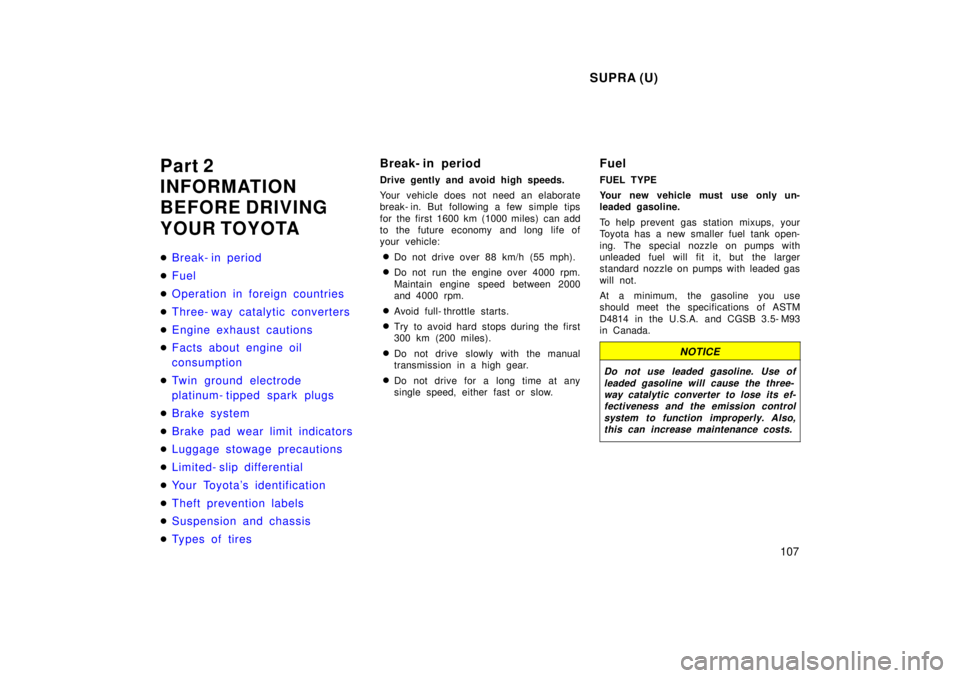
SUPRA (U)107
Part 2
INFORMATION
BEFORE DRIVING
YOUR TOYOTA �
Break- in period
�Fuel
�Operation in foreign countries
�Three- way catalytic converters
�Engine exhaust cautions
�Facts about engine oil
consumption
�Twin ground electrode
platinum- tipped spark plugs
�Brake system
�Brake pad wear limit indicators
�Luggage stowage precautions
�Limited- slip differential
�Your Toyota's identification
�Theft prevention labels
�Suspension and chassis
�Types of tires
Break- in period
Drive gently and avoid high speeds.
Your vehicle does not need an elaborate
break- in. But following a few simple tips
for the first 1600 km (1000 miles) can add
to the future economy and long life of
your vehicle:
� Do not drive over 88 km/h (55 mph).
� Do not run the engine over 4000 rpm.
Maintain engine speed between 2000
and 4000 rpm.
� Avoid full- throttle starts.
� Try to avoid hard stops during the first
300 km (200 miles).
� Do not drive slowly with the manual
transmission in a high gear.
� Do not drive for a long time at any
single speed, either fast or slow. Fuel
FUEL TYPE
Your new vehicle must use only un-
leaded gasoline.
To help prevent gas station mixups, your
Toyota has a new smaller fuel tank open-
ing. The special nozzle on pumps with
unleaded fuel will fit it, but the larger
standard nozzle on pumps with leaded gas
will not.
At a minimum, the gasoline you use
should meet the specifications of ASTM
D4814 in the U.S.A. and CGSB 3.5- M93
in Canada.
NOTICE
Do not use leaded gasoline. Use of
leaded gasoline will cause the three-way catalytic converter to lose its ef-
fectiveness and the emission control
system to function improperly. Also,this can increase maintenance costs.
Page 113 of 191
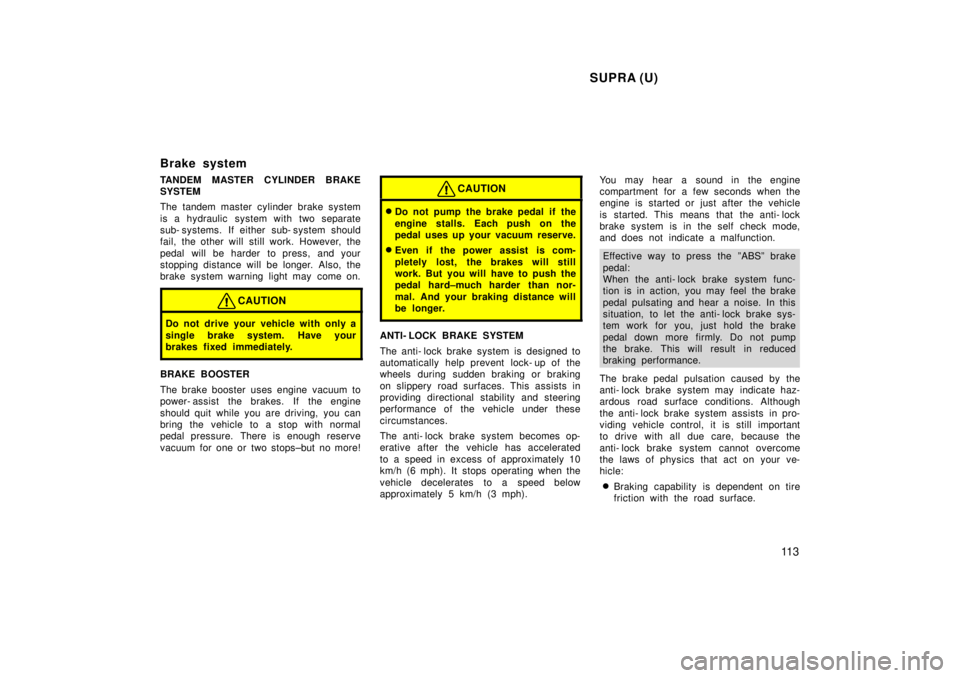
SUPRA (U)11 3
Brake system
TANDEM MASTER CYLINDER BRAKE SYSTEM
The tandem master cylinder brake system
is a hydraulic system with two separate
sub- systems. If either sub- system s
hould
fail, the other will still work. However, the
pedal will be harder to press, and your
stopping distance will be longer. Also, the
brake system warning light may come on.
CAUTION
Do not drive your vehicle with only a
single brake system. Have your
brakes fixed immediately.
BRAKE BOOSTER
The brake booster uses engine vacuum to
power- assist the brakes. If the engine
should quit while you are driving, you can
bring the vehicle to a stop with normal
pedal pressure. There is enough reserve
vacuum for one or two stops±but no more!
CAUTION
� Do not pump the brake pedal if the
engine stalls. Each push on the
pedal uses up your vacuum reserve.
� Even if the power assist is com-
pletely lost, the brakes will still
work. But you will have to push the
pedal hard±much harder than nor-
mal. And your braking distance will
be longer.
ANTI- LOCK BRAKE SYSTEM
The anti- lock brake system is designed to
automatically help prevent lock- up of the
wheels during sudden braking or braking
on slippery road surfaces. This assists in
providing directional stab ility and steering
performance of the vehicle under these
circumstances.
The anti- lock brake system becomes op-
erative after the vehicle has accelerated
to a speed in excess of approximately 10
km/h (6 mph). It stops operating when the
vehicle decelerates to a speed below
approximately 5 km/h (3 mph). You may hear a sound in the engine
compartment for a few seconds when the
engine is started or just after the vehicle
is started. This means that the anti- lock
brake system is in the self check mode,
and does not indicate a malfunction.
Effective way to press the ºABSº brake
pedal:
When the anti- lock brake system func-
tion is in action, you may feel the brake
pedal pulsating and hear a noise. In this
situation, to let the anti- lock brake sys-
tem work for you, just hold the brake
pedal down more firmly. Do not pump
the brake. This will result in reduced
braking performance.
The brake pedal pulsation caused by the
anti- lock brake system may indicate haz-
ardous road surface conditions. Although
the anti- lock brake system assists in pro-
viding vehicle control, it is still important
to drive with all due care, because the
anti- lock brake system cannot overcome
the laws of physics that act on your ve-
hicle: � Braking capab ility is dependent on tire
friction with the road surface.
Page 122 of 191
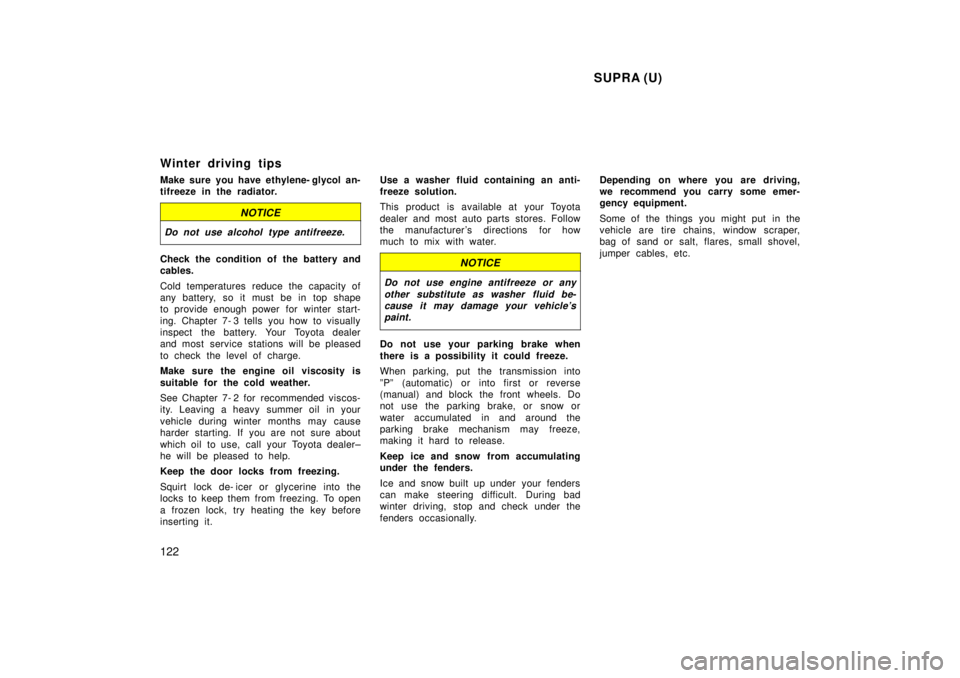
SUPRA (U)
122
Winter driving tips
Make sure you have ethylene- glycol an-
tifreeze in the radiator.
NOTICE
Do not use alcohol type antifreeze.
Check the condition of the battery and
cables.
Cold temperatures reduce the capacity of
any battery, so it must be in top shape
to provide enough power for winter start-
ing. Chapter 7- 3 tells you how to visually
inspect the battery. Your Toyota dealer
and most service stations will be pleased
to check the level of charge.
Make sure the engine oil viscosity is
suitable for the cold weather.
See Chapter 7- 2 for recommended viscos-
ity. Leaving a heavy summer oil in your
vehicle during winter months may cause
harder starting. If you are not sure about
which oil to use, call your Toyota dealer±
he will be pleased to help.
Keep the door locks from freezing.
Squirt lock de- icer or glycerine into the
locks to keep them from freezing. To open
a frozen lock, try heating the key before
inserting it.
Use a washer fluid containing an anti-
freeze solution.
This product is available at your Toyota
dealer and most auto parts stores. Follow
the manufacturer 's directions for how
much to mix with water.NOTICE
Do not use engine antifreeze or any
other substitute as washer fluid be-cause it may damage your vehicle's paint.
Do not use your parking brake when
there is a possibility it could freeze.
When parking, put the transmission into
ºPº (automatic) or into first or reverse
(manual) and block the front wheels. Do
not use the parking brake, or snow or
water accumulated in and around the
parking brake mechanism may freeze,
making it hard to release.
Keep ice and snow from accumulating
under the fenders.
Ice and snow built up under your fenders
can make steering difficult. During bad
winter driving, stop and check under the
fenders occasionally. Depending on where you are driving,
we recommend you carry some emer-
gency equipment.
Some of the things you might put in the
vehicle are tire chains, window scraper,
bag of sand or salt, flares, small shovel,
jumper cables, etc.
Page 123 of 191

SUPRA (U)123
Trailer towing
Toyota does not recommend towing a trail-
er with your Supra. It is not designed for
trailer towing.
Getting more kilometers/mileage from a
liter/gallon of fuel is easyÐjust take it
easy. It will help make your vehicle last
longer, too. Here are some specific tips
on how to save money on both fuel and
repairs:
� Keep your tires inflated at the cor-
rect pressure. Underinflation causes
tire wear and wastes fuel. See Chapter
7- 2 for instructions.
� Do not carry unneeded weight in
your vehicle. Excess weight puts a
heavier load on the engine, causing
greater fuel consumption.
� Avoid lengthy warm- up idling. Once
the engine is running smoothly, begin
drivingÐbut gently. Remember, howev-
er, that on cold winter days this may
take a little longer.
� Accelerate slowly and smoothly.
Avoid jackrabbit starts. Get into high
gear as quickly as possible.
� Avoid long engine idling. If you have
a long wait and you are not in traffic,
it is better to turn off the engine and
start again later.
� Avoid engine lug or overrevving. Use
a gear position suitable for the road on
which you are travelling. �
Avoid continuous speeding up and
slowing down. Stop- and- go driving
wastes fuel.
� Avoid unnecessary stopping and
braking. Maintain a steady pace. Try
to time the traffic signals so you only
need to stop as little as possible or
take advantage of through streets to
avoid traffic lights. Keep a proper dis-
tance from other vehicles to avoid sud-
den braking. This will also reduce wear
on your brakes.
� Avoid heavy traffic or traffic jams
whenever possible.
� Do not rest your foot on the clutch
or brake pedal. This causes needless
wear, overheating and poor fuel econo-
my.
� Maintain a moderate speed on high-ways. The faster you drive, the greater
the fuel consumption. By reducing your
speed, you will cut down on fuel con-
sumption.
� Keep the front wheels in proper
alignment. Avoid hitting the curb and
slow down on rough roads. Improper
alignment not only causes faster tire
wear but also puts an extra load on
the engine, which, in turn, wastes fuel.
How to save fuel and make
your vehicle last longer, too